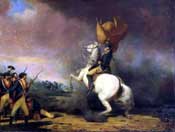Princeton - New Jersey Historic Site

THE BATTLE OF PRINCETON
Fresh off his surprise victory at the Battle of Trenton one week before, Washington and his men were invigorated for the first time in many months, ready to repeat their success against the British. Washington crossed back over the Delaware River to camp on the Pennsylvania side while he formulated a new strategy. He knew of a British outpost at Princeton, but was unsure of any surrounding fortifications. General Cadwalader went over the river on December 30, 1776 and reported back to Washington that there were no Hessian or other enemy positions in sight. This gave Washington the go-ahead to launch another assault.
British General Howe ordered General Cornwallis southward to pursue Washington’s Army. Early in January 1777, Cornwallis was hoping to smash the enemy and put an end to the rebellion. It didn’t quite work out that way. Although Cornwallis left a rear guard at Princeton, he proceeded toward Trenton with 5,500 men. When he arrived in the city, he found Washington’s troops entrenched on low hills around the town. Cornwallis decided to let his men rest, as he figured Washington was trapped and had nowhere to go. That was a mistake. Washington shrewdly had 400 of his men stay behind, leaving their campfires burning to give the impression his entire Army was there while he and most of his troops headed eastward and then north toward Princeton. As the Commander was on his way north, many of Americans led by General Mercer were attacked near Stony Creek by British General Mawhood, whose aggressive bayonet charges overwhelmed the tires soldiers. Only when Pennsylvania reinforcements and then later General Washington himself came to the front lines to offer yells of encouragement did they manage to push the British back.
Washington then turned his sights again on Princeton, where only a small contingent of about 200 British soldiers remained. Washington’s former aide-de-camp Captain Alexander Hamilton led an attack against the enemy who barricaded themselves inside Nassau Hall. On January 2, 1777 after a furious cannonade, the straggling British soldiers capitulated, handing Washington yet another much needed victory.Today the site is part of the Princeton Battlefield State Park where you can walk the battlefield and visit the Clarke House Museum.
